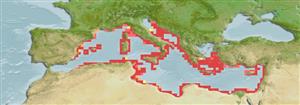>
Gobiesociformes (Clingfishes) >
Gobiesocidae (Clingfishes and singleslits) > Lepadogastrinae
Etymology: Gouania: From Antoine Gouan, in Montpellier was the author of a "Historia piscium" (Ref. 45335).
Eponymy: Dr Antoine Gouan (1733–1821) was a French naturalist, a pioneer of Linnaean taxonomy in France, who was born and lived in Montpellier. [...] Professor Carl Ludwig Willdenow (1765–1812) was a German botanist who mainly undertook taxonomic studies based on collections sent to him by other naturalists. [...] (Ref. 128868), visit book page.
More on author: Risso.
Environment: milieu / climate zone / depth range / distribution range
Ecología
marino demersal; rango de profundidad 0 - 2 m (Ref. 123696). Subtropical; 45°N - 30°N, 1°W - 36°E
Mediterranean Sea: restricted to the western Mediterranean basin with an easternmost record from Messina (Sicily).
Tamaño / Peso / Age
Maturity: Lm ? range ? - ? cm
Max length : 4.6 cm SL macho / no sexado; (Ref. 123696)
Short description
Claves de identificación | Morfología | Morfometría
Vértebra: 37 - 38. This species is distinguished from its congeners by the following set of characters: dorsal head profile straight between nape above eye and upper lip tip; the posterior angle of jaws extends to between a vertical line drawn through the posterior edge of the anterior nostril and a vertical line drawn through the anterior edge of the eye; infraorbital invagination vertical to posterior part of the eye; posterior opercular edge w-shaped with 2 equally long tips; longitudinal infralateral and suborbital transversal rows of superficial neuromasts are placed in the well-defined deep groove; trunk cross-section behind pectoral fin base half oval with straight ventral side; body granules shallow and inconspicuous; vertical eye diameter 2.6-3.3% of SL; horizontal eye diameter 2.3–2.9% of SL; head length 24.3-28.8% of SL; pectoral-fin length 8.6-9.3% of SL; prepectoral distance 24.4-28.4% of SL; ventral adhesive disc length 17.1-19.3% of SL; caudal-fin length 13.5-15.5% of SL; moderate number of vertebrae for the genus 37-38; pharyngeal jaws with small ceratobranchial 5, having several small conical teeth; nasal bones club-shaped; star-like pigmentation around eyes, body colouration when alive dark with clear stripes visible in less pigmented specimens (Ref. 123696).
Inhabits shallow waters (Ref. 10954). It reaches highest abundances in pebble and boulder beaches of less than 0.5 m depth (24 individuals/m2 in Messina), but reported to be found down to 2 m of water depth. It was also observed to occur with Lepadogaster lepadogaster and that males build and guard nests under boulders during spawning season (Ref. 123696),
Life cycle and mating behavior
Madurez | Reproducción | Puesta | Huevos | Fecundidad | Larva
Wagner, M., M. Kovačic and S. Koblmüller, 2021. Unravelling the taxonomy of an interstitial fish radiation: Three new species of Gouania (Teleostei: Gobiesocidae) from the Mediterranean Sea and redescriptions of G. willdenowi and G. pigra. J. Fish Biol. 98(1):64-88. (Ref. 123696)
IUCN Red List Status (Ref. 130435: Version 2024-1)
Threat to humans
Harmless
Human uses
Herramientas
Special reports
Download XML
Fuentes de Internet
Estimates based on models
Preferred temperature (Ref.
123201): 17.7 - 21.8, mean 19.3 °C (based on 464 cells).
Phylogenetic diversity index (Ref.
82804): PD
50 = 1.0000 [Uniqueness, from 0.5 = low to 2.0 = high].
Bayesian length-weight: a=0.00513 (0.00205 - 0.01282), b=3.10 (2.88 - 3.32), in cm total length, based on LWR estimates for this (Sub)family-body shape (Ref.
93245).
Nivel trófico (Ref.
69278): 3.1 ±0.5 se; based on size and trophs of closest relatives
Resiliencia (Ref.
120179): Medio, población duplicada en un tiempo mínimo de 1.4-4.4 años (Preliminary K or Fecundity.).
Fishing Vulnerability (Ref.
59153): Low vulnerability (10 of 100).
Nutrients (Ref.
124155): Calcium = 229 [39, 929] mg/100g; Iron = 1.53 [0.53, 5.20] mg/100g; Protein = 3.01 [0.00, 6.87] %; Omega3 = 0.246 [0.093, 0.680] g/100g; Selenium = 5.31 [1.05, 20.19] μg/100g; VitaminA = 58.3 [13.0, 249.9] μg/100g; Zinc = 1.68 [0.78, 3.62] mg/100g (wet weight);
